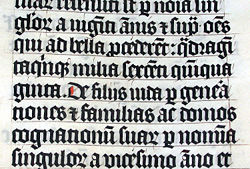Latin
2008/9 Schools Wikipedia Selection. Related subjects: Languages
| Latin Lingua Latīna |
||
|---|---|---|
| Pronunciation: | /laˈtiːna/ | |
| Spoken in: | ||
| Language extinction: | Late Latin developed into various Romance languages by the 9th century (into Vulgar Latin and then Italian, French, Portuguese, Romanian, Catalan and Spanish) | |
| Language family: | Indo-European Italic Latino-Faliscan Latin |
|
| Official status | ||
| Official language in: | Vatican City Used for official purposes, but not spoken in everyday speech |
|
| Regulated by: | Opus Fundatum Latinitas (Roman Catholic Church) |
|
| Language codes | ||
| ISO 639-1: | la | |
| ISO 639-2: | lat | |
| ISO 639-3: | lat | |
| Note: This page may contain IPA phonetic symbols in Unicode. | ||
Latin (lingua Latīna, pronounced [laˈtiːna]) is an ancient Indo-European language that was spoken in the Roman Republic and the Roman Empire. It was also the de facto international language of science and scholarship in mid and western Europe until the 17th century. Through Roman conquest, Latin spread throughout the Mediterranean and a large part of Europe. It later evolved into the languages spoken in France, Italy, Romania and the Iberian peninsula, and through them to Central and South America. There are two distinctions of Latin: Classical Latin, the form used in poetry and formal prose, and Vulgar Latin, the name given to a common set of Latin based dialects, until they diverged into the various Romance languages. After the fall of the Western Roman Empire and the rise of the Catholic Church Latin became the ecclesiastical language of the Catholic Church and the lingua franca of educated classes in the West.
After 2,300 years, Latin began a slow decline around the 1600s. Vulgar Latin however was preserved in several regional dialects, which by the 800s had become the ancestors of today's Romance languages. Latin lives on in the form of Ecclesiastical Latin spoken in the Catholic Church. Some Latin vocabulary is still used in science, academia, and law. Classical Latin, the literary language of the late Republic and early Empire, is still taught in many primary, grammar, and secondary schools, often combined with Greek in the study of Classics, though its role has diminished since the early 20th century. The Latin alphabet, together with its modern variants such as the English and French alphabets, is the most widely used alphabet in the world.
History
Latin is a member of the Italic languages and its alphabet is based on the Old Italic alphabet, derived from the Greek alphabet. In the 9th or 8th century BC Latin was brought to the Italian peninsula by the migrating Latins who settled in Latium, around the River Tiber, where Roman civilization would develop. During those early years Latin came under the influence of the non- Indo-European Etruscan language of northern Italy.
Although surviving Roman literature consists almost entirely of Classical Latin, the actual spoken language of the Western Roman Empire was Vulgar Latin, which differed from Classical Latin in grammar, vocabulary, and (eventually) pronunciation.
Although Latin long remained the legal and governmental language of the Roman Empire, Greek became the dominant language of the well-educated elite, as much of the literature and philosophy studied by upper-class Romans had been produced by Greek (usually Athenian) authors. In the eastern half of the Roman Empire, which would become the Byzantine Empire after the final split of the Eastern and Western Roman Empires in 395, Greek eventually supplanted Latin as the legal and governmental language; and it had long been the lingua franca of most Eastern citizens (of all classes).
Orthography
To write Latin, the Romans invented the Latin alphabet, basing it on the Etruscan Alphabet, which itself was based on the Greek alphabet. The Latin alphabet lives today in modified form as the writing system for Romance, Celtic, Slavic, Germanic (inter alia English) and many other languages. The ancient Romans did not use punctuation, macrons, the letters j and u, lowercase letters, or interword spacing (though dots were occasionally placed between words that would otherwise be difficult to distinguish). So, a sentence originally written as:
- LVGETEOVENERESCVPIDINESQVE
would be rendered in a modern edition as
- Lūgēte, Ō Venerēs Cupīdinēsque
and translated as
- Mourn, O Venuses and Cupids
Legacy
The expansion of the Roman Empire spread Latin throughout Europe, and, eventually, Vulgar Latin began to dialectize, based on the location of its various speakers. Vulgar Latin gradually evolved into a number of distinct Romance languages, a process well under way by the 9th century. These were for many centuries only oral languages, Latin still being used for writing.
For example, Latin was still the official language of Portugal in 1296, after which it was replaced by Portuguese. Many of these "daughter" languages, including Italian, French, Spanish, Portuguese, Romanian, Catalan, and Romansh, flourished, the differences between them growing greater and more formal over time.
Out of the Romance languages, Italian is the purest descendant of Latin in terms of vocabulary, though Sardinian is the most conservative in terms of phonology.
Some of the differences between Classical Latin and the Romance languages have been used in attempts to reconstruct Vulgar Latin. For example, the Romance languages have distinctive stress on certain syllables, whereas Latin had this feature in addition to distinctive length of vowels. In Italian and Sardo logudorese, there is distinctive length of consonants as well as stress; in Spanish and Portuguese, only distinctive stress; while in French length (for most speakers) and stress are no longer distinctive. Another major distinction between Romance and Latin is that all Romance languages, excluding Romanian, have lost their case endings in most words, except for some pronouns. Romanian exhibits a direct case (nominative/accusative), an indirect case (dative/genitive), a vocative and is the only language which has retained the neuter gender and at least a partial declension from Latin.
There has also been a major Latin influence in English. English is Germanic in grammar, largely Romance in vocabulary, with Greek influence. Sixty percent of the English vocabulary has its roots in Latin (although a large amount of this is indirect, mostly via French). In the medieval period, much of this borrowing occurred through ecclesiastical usage established by Saint Augustine of Canterbury in the 6th century, or indirectly after the Norman Conquest—through the Anglo-Norman language.
From the 16th to the 18th centuries, English writers cobbled together huge numbers of new words from Latin and Greek roots. These words were dubbed " inkhorn" or " inkpot" words, as if they had spilled from a pot of ink. Many of these words were used once by the author and then forgotten, but some were so useful that they survived. Imbibe, extrapolate, dormant and employer are all inkhorn terms created from Latin words. Many of the most common polysyllabic "English" words are simply adapted Latin forms, in a large number of cases adapted by way of Old French.
Latin mottos are used as guidelines by many organizations.
Grammar
Latin is a synthetic, fusional language: affixes (often suffixes, which usually encode more than one grammatical category) are attached to fixed stems to express gender, number, and case in adjectives, nouns, and pronouns—a process called declension. Affixes are attached to fixed stems of verbs, as well, to denote person, number, tense, voice, mood, and aspect—a process called conjugation.
Nouns
There are six main Latin noun cases. These play a major part in determining a noun's syntactic role in the sentence, so word order is not as important in Latin as it is in other languages, such as English. Because of noun cases, words can often be moved around in a sentence without significantly altering its meaning, though the emphasis will have altered. The cases, with their most important uses, are these:
- Nominative: used when the noun is the subject of the sentence or phrase, or when functioning as a predicative of the subject.
- Vocative: used when the noun is used in a direct address (only for male singular addression ending on -us).
- Accusative: used when the noun is the direct object of the sentence/phrase, with certain prepositions, or as the subject of an infinitive.
- Genitive: used when the noun is the possessor of an object (example: "the horse of the man", or "the man's horse" - in both of these cases, the word man would be in the genitive case when translated into Latin). Also indicates material of which something greater is made of (example: "a group of people"; "a number of gifts"—people and gifts would be in the genitive case). Some nouns are genitive with special verbs too.
- Dative: used when the noun is the indirect object of the sentence, with special verbs, with certain prepositions, and if used as agent, reference, or even possessor.
- Ablative: used when the noun demonstrates separation or movement from a source, cause, agent, or instrument, or when the noun is used as the object of certain prepositions; adverbial.
There is also a seventh case, called the Locative case, used to indicate a location (corresponding to the English "in" or "at"). This is far less common than the other six cases of Latin nouns and usually applies to city names like Athene.
Verbs
Verbs in Latin are usually identified by four main conjugations, groups of verbs with similarly inflected forms. The first conjugation is typified by active infinitive forms ending in -āre, the second by active infinitives ending in -ēre, the third by infinitives ending in -ere, and the fourth by active infinitives ending in -īre. However, there are exceptions to these rules. Further, there is a subset of the 3rd conjugation, the -iō verbs, which behave somewhat like the 4th conjugation. There are six general tenses in Latin (present, imperfect, future, perfect, pluperfect, and future perfect), four grammatical moods (indicative, infinitive, imperative and subjunctive), six persons (first, second, and third, each in singular and plural), two voices (active and passive), and a few aspects. Verbs are described by four principal parts:
- The first principal part is the first person, singular, present tense, and it is the indicative mood form of the verb.
- The second principal part is the active, present tense, infinitive form of the verb.
- The third principal part is the first person, singular, perfect tense, active indicative mood form of the verb.
- The fourth principal part is the supine form, or alternatively, the participial form, nominative case, singular, perfect tense, passive voice participle form of the verb. The fourth principal part can show either one gender of the participle, or all three genders (-us for masculine, -a for feminine, and -um for neuter). It can also be the future participle when that verb cannot be made passive.
Instruction in Latin
The linguistic element of Latin courses offered in secondary schools and in universities is primarily geared toward an ability to translate Latin texts into modern languages, rather than using it for the purpose of oral communication. As such, the skills of reading and writing are heavily emphasized, and speaking and listening skills are left inchoate.
However, there is a growing movement, sometimes known as the Living Latin movement, whose supporters believe that Latin can be taught in the same way that modern "living" languages are taught, i.e., as a means of both spoken and written communication. This approach to learning the language assists speculative insight into how ancient authors spoke and incorporated sounds of the language stylistically; patterns in Latin poetry and literature can be difficult to identify without an understanding of the sounds of words.
Living Latin instruction is provided in states like the Vatican, and some Institutions in the U.S. like the University of Kentucky. In Great Britain, the Classical Association encourages this approach, and Latin language books describing the adventures of a mouse called Minimus have been published. In the United States, the National Junior Classical League (with more than 50,000 members) encourages high school students to pursue the study of Latin, and the National Senior Classical League encourages college students to continue their studies of the language.
Many international auxiliary languages have been heavily influenced by Latin. Interlingua, which lays claim to a sizeable following, is sometimes considered a simplified, modern version of the language. Latino sine Flexione, popular in the early 20th century, is a language created from Latin with its inflections dropped.
Latin translations of modern literature such as Paddington Bear, Winnie the Pooh, Tintin, Asterix, Harry Potter, Le Petit Prince, Max und Moritz, How the Grinch Stole Christmas, and The Cat in the Hat are intended to bolster interest in the language.
Modern use of Latin
- Today, Latin terminology is widely used, inter alia, in philosophy, medicine, biology, and law, in terms and abbreviations such as (among other things) subpoena duces tecum, q.i.d. (quater in die: "four times a day"), and inter alia (among other things). The Latin terms are used in isolation, as technical terms.
- Films such as Sebastiane and The Passion of the Christ have been made with dialogue in Latin.
- The Pope delivers his written messages in Latin.
- Many organizations today also have Latin mottos, such as " Semper fidelis" (always faithful), the motto of The United States Marine Corps.
- Some universities still hold graduation ceremonies in Latin.
- Contemporary musical compositions may integrate a chorus which sings in Latin for an aesthetic effect.
- Spells in the Harry Potter series are sometimes made from Latin words. For example, accio, a Summoning Charm, is Latin for "I summon".
Future use of Latin
In the science fiction novel Manifold: Space by Stephen Baxter, in the far future, isolated human colonies have endured linguistic drift to the point their independent languages are unknown to each other. As a result, they have defaulted to using Latin for inter-colony communication and trade.



